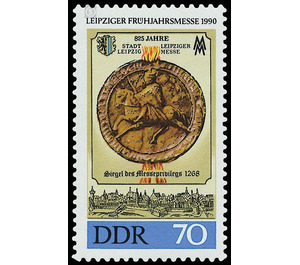Commemorative stamp series - Germany / German Democratic Republic 1990 - 70 Pfennig
Theme: Calender
| Country | Germany / German Democratic Republic |
| Issue Date | 1990 |
| Face Value | 70.00 |
| Color | brown |
| Perforation | K 12 1/2: 13 |
| Printing Type | offset |
| Stamp Type | Postage stamp |
| Item Type | Stamp |
| Chronological Issue Number | 3058 |
| Chronological Chapter | GER-DDR |
| SID | 519066 |
| In 14 Wishlists | |
Leipzig Spring Fair 1990 On the occasion of the anniversary 825 years of the city of Leipzig and the Leipzig Fair, the Ministry of Posts and Telecommunications of the German Democratic Republic issued two multicolored special postage stamps. Special cancellation from March 6 to May 5, 1990 Leipzig Spring Fair 1990 The Leipzig Fair celebrates its 825th anniversary in 1990. Leipzig was around 1165 with the award of city law also confirmed the right to regularly hold remote markets. They were later called fairs. Since then, large markets have been regularly organized in the city of plague two to three times a year. In addition to the jubilee or Easter Mass - from which the spring fair, which now always takes place in mid-March, and the Michaelismesse - the predecessor of the autumn fair, which was now at the beginning of September - there was also a New Year fair in January at the beginning of this century. In the past centuries, Leipzig's city fathers were also responsible for the Leipzig Trade Fair. In order to safeguard its trade-fair rights vis-à-vis other cities, the Leipzig Council was always confirmed by every new German king or emperor - and sometimes even by the pope. These so-called fair privileges are mostly artfully designed and formulated as well as bearing powerful seals, which are still kept and kept in the city archives. On the occasion of the anniversary of the fair, two of the most beautiful seals of such trade fair privileges will be displayed on the special postage stamp for the Leipzig Spring Fair 1990. The one seal comes from the privilege of 1268, signed by Margrave Dietrich von Landsberg on 1 March of that year in Leipzig. It has entered the history of the trade fair as a "escorting privilege". In it, the sovereign, to whose possession Leipzig belonged at that time, assures the safe conduct and protection of her person and her goods to all merchants traveling to the Leipzig Trade Fair, participating in them or returning home. The document expressly emphasizes that this protection was granted even if the Margrave were "in open feud" with the sovereign of a merchant. For Leipzig and its fairs, these documents were important and valuable in competing for supremacy among the central German long-distance markets. No wonder that the sovereigns paid for their signatures very well, so that each time the Leipzig Council had to dig deep into the city. But with that they had created an important condition for the continuous holding and further development of their fair. For the peculiarity and uniqueness of the Leipzig Fair is that it has been carried out uninterruptedly since its foundation 825 years ago. There have only been two interruptions during this long period, in the Middle Ages during a terrible plague epidemic and in the early forties of this century. On the special postage stamps are the Leipzig city coat of arms with the Leipzig lion on the upper left and the Leipzig Trade Fair's landmark on the top right. The M. stands on top of each other and symbolizes the term "Mustermesse". Below the seals is a redrawn view of the old Leipzig.


